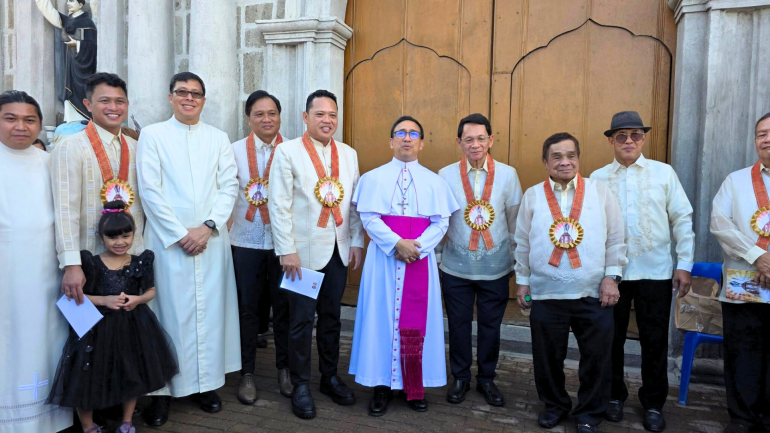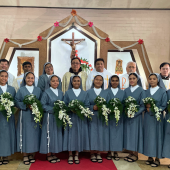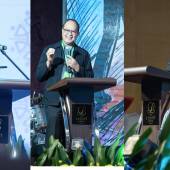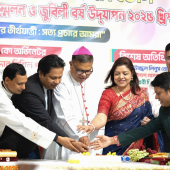Philippines: Centuries-old Saint Polycarp church renovated; faithful urged to emulate patron

The Province of Laguna in the Philippines is home to the only parish in the entire country dedicated to Saint Polycarp, a Greek bishop of Smyrna and an Apostolic Father of the Church. One of the oldest churches in the archipelago, it stands as a silent witness to the bravery and faith of the Filipino people.
First built in 1637 by the Augustinians, the original church was destroyed due to loose soil and severe flooding. In 1763, Franciscan missionaries began constructing a new church in the town proper of Cabuyao, where it still stands today.
The church showcases the craftsmanship of the Franciscans in ecclesiastical architecture. Gerard Lico, an architect and architectural historian from the University of the Philippines Diliman, described its façade as neoclassical, with “a retablo-like configuration but refashioned according to the stylistic principles of the Palladian Tuscan Order.”
Saint Polycarp Church was also the site of the massacre of 52 members of the Sakdal Movement, a brief peasant rebellion against oppressive land tenancy, on May 3, 1935. The revolutionaries, called “Sakdalistas,” retreated to the church after attempting to start a nationwide uprising. A decade later, during the Japanese occupation in 1945, the parish church was converted into a makeshift hospital for wounded soldiers and even used as a stable for horses.
After more than 250 years of standing strong, Saint Polycarp Church began to show signs of deterioration. Heritage conservation experts who inspected the church discovered major cracks and fissures in the masonry dome and belfry, which worsened after a powerful earthquake struck the region in 2021. In response, the parish launched a three-phase restoration project to preserve the 18th-century structure. The work began with the reconstruction of the façade and belfry, and concluded with the restoration of the retablo, which was faithfully recreated from old photographs of the original design.
The newly renovated retablo now houses the antique image of Saint Polycarp, which had been under the care of the Tambuatco-Bella Family. Alongside the chief patron are four other saints closely connected to his life: Saint Clement of Rome, Saint Ignatius of Antioch, Saint Papias of Hierapolis, and Saint John the Apostle.
In addition to the retablo, the final phase of the restoration also included the construction of a communion rail, side retablos, and a new altar.
The new retablo and altar were consecrated by Bishop Marcelino Antonio Maralit, Jr. of the Diocese of San Pablo, Laguna, on October 1.
In his homily, he reminded the faithful that nothing can ever compensate for or replace God in life. “Whenever the Holy Mass is celebrated here in your church, do know that the path to glory is none other than Jesus,” he said. “The highest form of prayer and communion with Him is the Holy Eucharist.”
Bishop Maralit also urged the faithful to draw inspiration from their new retablo, filled with images of holy men and women, as they continue their own journeys toward holiness with Christ.
“Your stories will be watched by heaven,” the prelate said. “Look at your retablo and remember that one day you will join those saints who have triumphed in heaven.”
In his thanksgiving message, parish priest Father Mardie Maligat said that their newly renovated church will serve as an inspiration as their community continues to grow in faith.
“May our church be a home for a community that strives to become holy, and may anyone who enters here find refuge, peace, and hope,” he said.
Saint Polycarp Parish in Cabuyao is one of the many centuries-old churches in the Philippines. Despite rapid technological progress and fast-paced modernity, these places of worship continue to stand strong amid change. Here, the preservation of rich local heritage remains a top priority, and the mission endures, to spread the Word of God, who alone withstands the test of time.
(Luke Godoy is a freelance writer based in the Philippines who contributes regularly to RVA.)
Radio Veritas Asia (RVA), a media platform of the Catholic Church, aims to share Christ. RVA started in 1969 as a continental Catholic radio station to serve Asian countries in their respective local language, thus earning the tag “the Voice of Asian Christianity.” Responding to the emerging context, RVA embraced media platforms to connect with the global Asian audience via its 21 language websites and various social media platforms.













